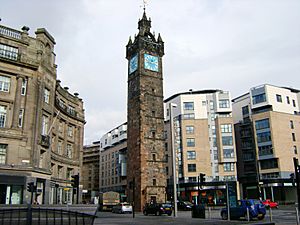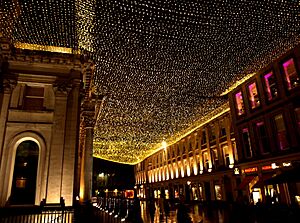Glasgow city centre facts for kids
Glasgow City Centre is the main part of Glasgow, Scotland, where lots of businesses are located. It's like the heart of the city! It has clear borders: to the east are Saltmarket, High Street, and Castle Street. The River Clyde is to its south. To the west and north, you'll find the M8 motorway.
This important area includes places like Garnethill, Blythswood Hill, and Merchant City. It also covers parts of Cowcaddens, Townhead, Anderston, and Calton.
Shopping and Fun in the City Centre

The city centre is built on a grid system of streets. This is similar to how cities like Barcelona are designed. It sits on the north side of the River Clyde.
The very heart of the city is George Square. You can see many of Glasgow's public statues here. The grand Victorian Glasgow City Chambers building is also in the square. This is where the Glasgow City Council has its main offices.
To the south and west, you'll find busy shopping streets. These include Argyle Street, Sauchiehall Street, and Buchanan Street. Buchanan Street has more fancy shops. It even won an award in 2008 for being a "Great Street."
The main shopping centres are Buchanan Galleries and the St. Enoch Centre. For designer brands, check out Princes Square and the Italian Centre. Glasgow is known as the United Kingdom's second biggest shopping area. It's only smaller than Central London.
The city centre also has many of Glasgow's main cultural spots. These are places where you can enjoy arts and entertainment.
- The Theatre Royal is home to Scottish Opera.
- Other theatres include The Pavilion and The King's Theatre.
- You can also visit the Glasgow Royal Concert Hall for music.
- The Glasgow Film Theatre shows movies.
- The Gallery of Modern Art (GoMA) displays amazing art.
- The Mitchell Library is a huge public library.
- Other places are the Centre for Contemporary Arts and McLellan Galleries.
- Don't miss The Lighthouse Museum, which is about architecture and design.
The world's tallest cinema, Cineworld, is on Renfrew Street. It has eighteen screens!
The city centre is also home to four of Glasgow's universities and colleges. These are:
- The University of Strathclyde
- The Royal Conservatoire of Scotland (for performing arts)
- Glasgow School of Art
- Glasgow Caledonian University
Merchant City: History and Culture
To the east of the city centre is the Merchant City. This area has both businesses and homes. In the 1700s and early 1800s, it was where rich city merchants lived. Many of these were Tobacco Lords. Some streets are still named after them today.
As the Industrial Revolution brought more wealth, Glasgow grew westward. The old medieval centre was left behind. Glasgow Cross was the city's original centre. It is where High Street, Gallowgate, Trongate, and Saltmarket meet. A Mercat cross marks this spot.
Glasgow Cross also has the Tolbooth Clock Tower. This is all that's left of the first Glasgow City Chambers. That building was destroyed by fire in 1926. If you go north up High Street, you'll find the 15th-century Glasgow Cathedral. Nearby is the Provand's Lordship, a very old house. In the late 1800s, people moved away from this area. This was because of increasing pollution from industries.
Since the late 1980s, the Merchant City has been made new again. Old warehouses have been turned into fancy apartments. This has led to many new cafes and restaurants opening. You can also find high-end shops here.
The Merchant City is now Glasgow's growing "cultural quarter." This area is focused around King Street, Saltmarket, and Trongate. It is also where the yearly Merchant City Festival takes place.
Many art galleries have opened here. This started in the late 1980s. Artists could find cheap places to rent in empty shops or factories. Both independent art groups and Glasgow City Council saw the potential of the Merchant City as a cultural hub. A big result of this teamwork is Trongate 103. It has galleries, workshops, and artist studios.
The area also has several theatres and concert venues. These include the Tron Theatre, the Old Fruitmarket, and the City Halls.
Recently, the city council has made the Merchant City area bigger. It now stretches as far west as Buchanan Street. New metal signs show these boundaries.
Financial District: "Wall Street on Clyde"

On the western side of the city centre is Glasgow's financial district. It is officially called the International Financial Services District (IFSD). Some people jokingly call it the "square kilometre" or "Wall Street on Clyde."
Since the late 1980s, many modern office buildings have been built here. This has made the IFSD one of the UK's largest financial areas. Glasgow is known as a strong financial services centre. It also has many support services. This helps the city attract new businesses and grow existing ones.
Many big companies have offices or headquarters here. For example, 8 out of the 10 largest insurance companies in the UK have a base in Glasgow. These include Direct Line, Esure, AXA, and Norwich Union.
Important banks have also moved some of their services to Glasgow. These include JPMorgan Chase, Abbey, HBOS, Barclays Wealth, and Royal Bank of Scotland.
Other major organizations also have their headquarters in this district. These include:
- The Ministry of Defence (several departments)
- Clydeport
- The Glasgow Stock Exchange
- The Student Loans Company
- BT Group
- The Scottish Qualifications Authority
- Scottish Enterprise



